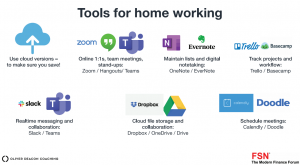With face-to-face meetings no longer an option (currently), working from home requires the use of different tools to maintain productivity and effectiveness. Thankfully, there are plenty of options that you can take advantage of, so if you’re not quite sure where to start, check out my suggested go-to digital tools below.
For online 1-2-1s, team meetings, stand-ups, download Zoom, Hangouts, Teams or GoToMeeting. All of these web-hosted services have great features to help you communicate effectively online.
For digital note-taking or maintaining lists, you can use Microsoft OneNote, Evernote, Google Keep, or even Google Sheets. Evernote is known as the leader in this space, allowing for the most note types, including, text, checklists, images, sketches, scanned documents, audio memo and clipped web pages.
To track projects and workflow, I recommend Trello, Asana or Basecamp. They all have many excellent features that simplify the complexities of managing a project, with everyone able to work on projects together, understand the status, roles and responsibilities and track metrics, keeping all the information in one place.
For real-time messaging and collaboration, use Slack or Microsoft Teams for flexible and easy communication. These platforms have multiple different workstreams at once, and the all-important ‘watercooler’ chat to keep team morale up!
For cloud file storage and online collaboration, Dropbox, Microsoft OneDrive and Google Drive allow you to securely and easily work on documents together, from anywhere.
To schedule meetings and book appointments, use Calendly or Doodle to save a lot of time with both your colleagues and clients. It can be hard enough to find time with everyone in the office, let alone remotely, so these tools make it easy to find time in everyone’s diary. They also support international time zones.
For month end close, forecasts and other finance rhythms, you can use Microsoft OneNote or DropBox Paper to collate information and collaborate on a process. For example, the team lead/controller can add their questions at the start of close, and the team can then work together to answer them. A record will be kept for each month so issues can be tracked over time, and comparators to prior periods are easier.
And remember to use cloud versions! Most productivity software, such as MS Office and Google Docs, have cloud versions. These make sure that work is saved regularly. Computer crashes, or even worse, laptop breakages can result in hours of lost work. Cloud files make sure there is a backup and you can keep working. Nothing should be saved locally. It’s a hard habit to start, but essential for remote working.

By Oliver Deacon, FSN Modern Finance Forum moderator on LinkedIn, Ex-Microsoft FD and Executive coach.
